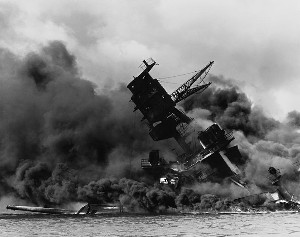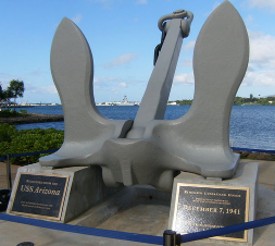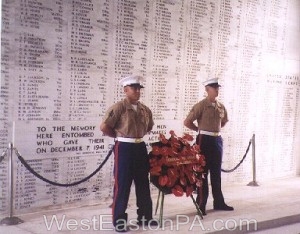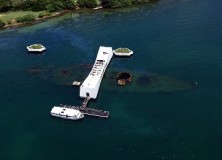
NOTE: This is a re-publication of a piece I originally placed on this website Dec.7, 2013. There are now only 5 survivors from the Arizona still living.
The attack on Pearl Harbor was a surprise military strike conducted by the Imperial Japanese Navy against the United States naval base at Pearl Harbor, Hawaii, on the morning of December 7, 1941. The attack on Pearl Harbor and other military bases located on Oahu, one of Hawaiian islands, led to the United States’ entry into World War II. It turned a nation of people whose majority favored a policy of isolationism before the sneak attack, into a global military superpower by the war’s end.
From the standpoint of the defenders, the Pearl Harbor attack commenced at 7:48 a.m. Hawaiian Time. The base was attacked by 353 Japanese fighters, bombers and torpedo planes in two waves, launched from six aircraft carriers.
All eight U.S. Navy battleships were damaged, with four being sunk. All but one were later raised, and six of the eight battleships returned to service and fought in the war. The Japanese also sank or damaged three cruisers, three destroyers, an anti-aircraft training ship, and one minelayer. 188 U.S. aircraft were destroyed; 2,402 Americans were killed and 1,282 wounded.
Important base installations such as the power station, shipyard, maintenance, and fuel and torpedo storage facilities, as well as the submarine piers and headquarters building (also home of the intelligence section) were not attacked. The failure of the Japanese to follow through with a third wave to eliminate these objectives would directly contribute to their loss of the war in the years that followed.
Japanese losses were light: 29 aircraft and five midget submarines lost, and 65 servicemen killed or wounded. One Japanese sailor, Kazuo Sakamaki, was captured when his miniature sub ran aground.

Having been stationed at Pearl Harbor and more specifically, Ford Island, where I had a view of the Arizona Memorial from my window each morning, the attack on Pearl Harbor was something tangible to me. Though it had occurred almost 20 years before my birth it became more than just old newsreel footage and pictures in magazines.
Throughout the 1950s there was discussion of scrapping the Arizona altogether. President Dwight D. Eisenhower approved the creation of the National Memorial in 1958. Enabling legislation required that the memorial budgeted at $500,000 be privately financed. It had a slow start in receiving funding until a popular singer, who having just finished an army enlistment took an interest in seeing it completed. On March 25, 1961, Elvis Presley performed a concert at Bloch Arena in Pearl Harbor. All ticket proceeds benefited the construction of the USS Arizona Memorial. The concert generated $54,678.73 – more than ten percent of the $515,728.37 needed to construct the monument. A commemorative plaque that honors the concert is located at the Bloch Arena complex on base.
The Elvis concert created not only money for the memorial, but also helped in getting media coverage for attracting additional funding from the public and the government. Though originally to be totally funded by the public, $200,000 of the memorial cost was eventually government subsidized.The memorial was completed in 1962.
I visited the memorial more than once during my 7 months in Hawaii, finding time between my military training, college courses, and beach trolling. From the glassless windows of the memorial you can look in the water below and see the hull of the USS Arizona, where it rests in ~40 feet of water and entombs the remains of 1,102 of the 1,177 sailors and marines who died while assigned to her that day. Among the dead are 23 sets of brothers, with an additional 14 survivors losing a brother. One pair of father and son serving together were killed.
Small drops of fuel oil constantly rise to the surface and spreads out along the waters surface creating a thin sheen. The oil seeping is sometimes referred to as, “the tears of the Arizona,” or “black tears.” The loss of fuel oil has been measured at 9 quarts per day. It’s estimated 500,000 gallons, of the original 1.5 million gallons of fuel remains inside the ship (she had just refueled the day before the attack) and did not burn off during the 2 1/2 days the ship blazed on the surface.
There are three main parts to the national memorial: entry, assembly room, and shrine. The central assembly room features seven large open windows on either wall and ceiling, to commemorate the date of the attack. The total number of windows is 21. This stands for a 21 gun salute, or 21 Marines standing at eternal parade rest over the tomb of the fallen. It also contains an opening in the floor overlooking the sunken decks. It is from this opening that visitors come to pay their respects by tossing flowers and lei in honor of the fallen sailors. An aerial view of the shrine provides the appearance of a Christian cross.

Inside the shrine at the far end is a marble wall that bears the names of all those 1,177 killed on the USS Arizona, protected behind velvet ropes. Contrary to popular belief, the USS Arizona is no longer in commission. The USS Arizona was stricken from the Naval Vessel Register in December of 1942. On March 7, 1950, the Arizona was symbolically “re-commissioned” when a flagpole was attached to the ship, where it remained for over 30 years. Though not actually recognized as part of the American fleet any longer, the USS Arizona is still treated as one of the current fleet by the naval military personnel.
U.S. naval ships will “Man the Rails” when arriving in ports. When doing so at Pearl Harbor all hands will salute the USS Arizona. A ship-to-ship salute is usually reserved for those carrying dignitaries, or only on very special occasions. In contrast, a salute to the USS Arizona is given without reservation.
As a special tribute to the ship and her lost crew, the United States flag still flies from the flagpole that was once attached to the severed mainmast of the sunken battleship (such as it was, when I was stationed at Pearl), but is now attached to the side of the memorial. It was removed from the ship shortly after the National Park Service took control of the memorial in 1980.

There are only 13 known living USS Arizona survivors. All known living survivors are US Navy, as the last US Marine survivor, Lamar Crawford, died on December 22, 2011.
The USS Arizona Memorial has come to commemorate all military personnel killed in the Pearl Harbor attack.
Disclaimer: On January 4, 2016, the owner of WestEastonPA.com began serving on the West Easton Council following an election. Postings and all content found on this website are the opinions of Matthew A. Dees and may not necessarily represent the opinion of the governing body for The Borough of West Easton.







